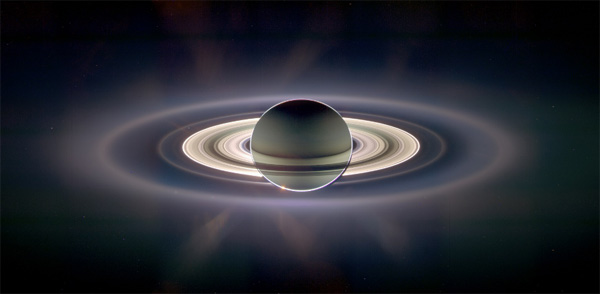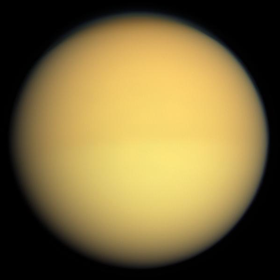
Finding a Diamond in the Cosmic Haystack
An AFSIG article by Paul Trittenbach
Located 1.4 billion kilometers (9.6AU) from the Sun is the second largest planet and sixth planet of the solar system: Saturn. Its beautiful ring structure makes it the most popular planet among amateur astronomers and the public alike. Like Jupiter, Saturn is a gas giant planet composed predominantly of Hydrogen and Helium.
Saturn was the most distant planet known to the people of the ancient world. It was not viewed through a telescope before 1610 when Galileo Galilei turned his 30-x refractor upon it. To his amazement, he saw a pair of objects on each side of the planet, and sketched Saturn as a three-bodied world. After numerous observations, he sketched these lobes as handles attached to either side of the planet.
In 1659 the Dutch astronomer Christian Huygens, using a more powerful telescope than Galileo’s, proposed that Galileo’s handles were in fact a thin flat ring that surrounded the planet. Later in that century, in 1675, the Italian born astronomer Jean-Dominique Cassini observed the division between what are called the A and B rings of Saturn. It is now known that the gravitational influence Saturn’s moon Mimas is responsible for this 4,800 mile-wide division, known as the Cassini division.
Saturn’s volume is 755 times greater than that of Earth. The winds of the planets’ upper atmosphere can reach up to 500 m/s, four and half times the speed of the fastest hurricane on Earth! Combined with heat rising up from the planet’s interior, these winds create the yellow and gold bands of the atmosphere. A day on Saturn lasts 10.7 hours and one year is equivalent to 29 Earth years.
Saturn’s rings are composed predominantly of water ice. The rings contain more than 23 times as much water as all the oceans of Earth. They consist of seven separate ring structures extending up to 282,000 km from the planet; about three quarters of the distance between Earth and the moon. The depth of the ring system is approximately 10 meters.
Saturn has 62 known moons. The largest moon, Titan, is bigger than the planet Mercury and the second largest moon in the solar system (only Jupiter’s Ganymede is bigger). Titan has a thick nitrogen atmosphere, similar to the early atmosphere of Earth. On Titan, the cold atmosphere causes methane — a normally gaseous compound on earth — to precipitate out of the atmosphere as rain. Titan has large lakes of methane and planetary scientists are interested in it because of its potential to harbor basic life. Further study of Titan may help scientists to better understand early Earth. Titan is the only other moon in the solar system where NASA has landed a probe.
 Saturn’s moon Titan was discovered by Christian Huygens in the year 1655. Giovanni Cassini followed up with the discovery of the next four moons: Iapetus, Rhea, Dione and Tethys. In 1784 William Herschel discovered Mimas and didn’t sell at this. More than 50 years had passed before the discovery of Hyperion and Phoebe. As the size and resolving capacity of telescopes increased, so too did the number of discoveries of new moons around Saturn. Additional discoveries came via robotic probes, such as the Cassini mission earlier this century.
Saturn’s moon Titan was discovered by Christian Huygens in the year 1655. Giovanni Cassini followed up with the discovery of the next four moons: Iapetus, Rhea, Dione and Tethys. In 1784 William Herschel discovered Mimas and didn’t sell at this. More than 50 years had passed before the discovery of Hyperion and Phoebe. As the size and resolving capacity of telescopes increased, so too did the number of discoveries of new moons around Saturn. Additional discoveries came via robotic probes, such as the Cassini mission earlier this century.
Iapetus is a two-faced world — having one side that is highly reflective and as white as snow and another side as dark as black velvet. Mimas has an enormous impact crater on one side that nearly split the moon and half. The moon Enceladus has a fractured surface where water can escape, through evaporation, into the atmosphere. This displays evidence of active volcanism on the planet. Phoebe and several other moons, orbits retrograde to the planet. Sixteen of Saturn’s moons orbit and a tidal lock with the world, always keeping one face toward the planet.
Studies by NASA’s Cassini probe indicate that Saturn has a dense core of rock and ice, solidified by Saturn’s intense pressure. The core is surrounded by a metallic liquid hydrogen layer — similar to that of Jupiter, but considerably smaller. Saturn’s magnetic field is 578 times as powerful as that of Earth, but still smaller than Jupiter’s.
The rings, and most of the moons lie totally within the influence of the planet’s magnetosphere. The magnetosphere is a magnetic field surrounding a planet, where electrically charged particles of the solar wind interact with the magnetic fields of the planet. This is the area in which planetary auroras are created.
Saturn can be easily observed through a small telescope, making it accessible to anyone. The deadline for our observing season, however, may be closing within the next month as monsoons begin to dominate our southwestern sky. The planet reaches opposition on the morning of June 3 at 1:00 AM. But any time throughout the month of June and the entire summer will be good for seeing the planet, which is available to us until October.

